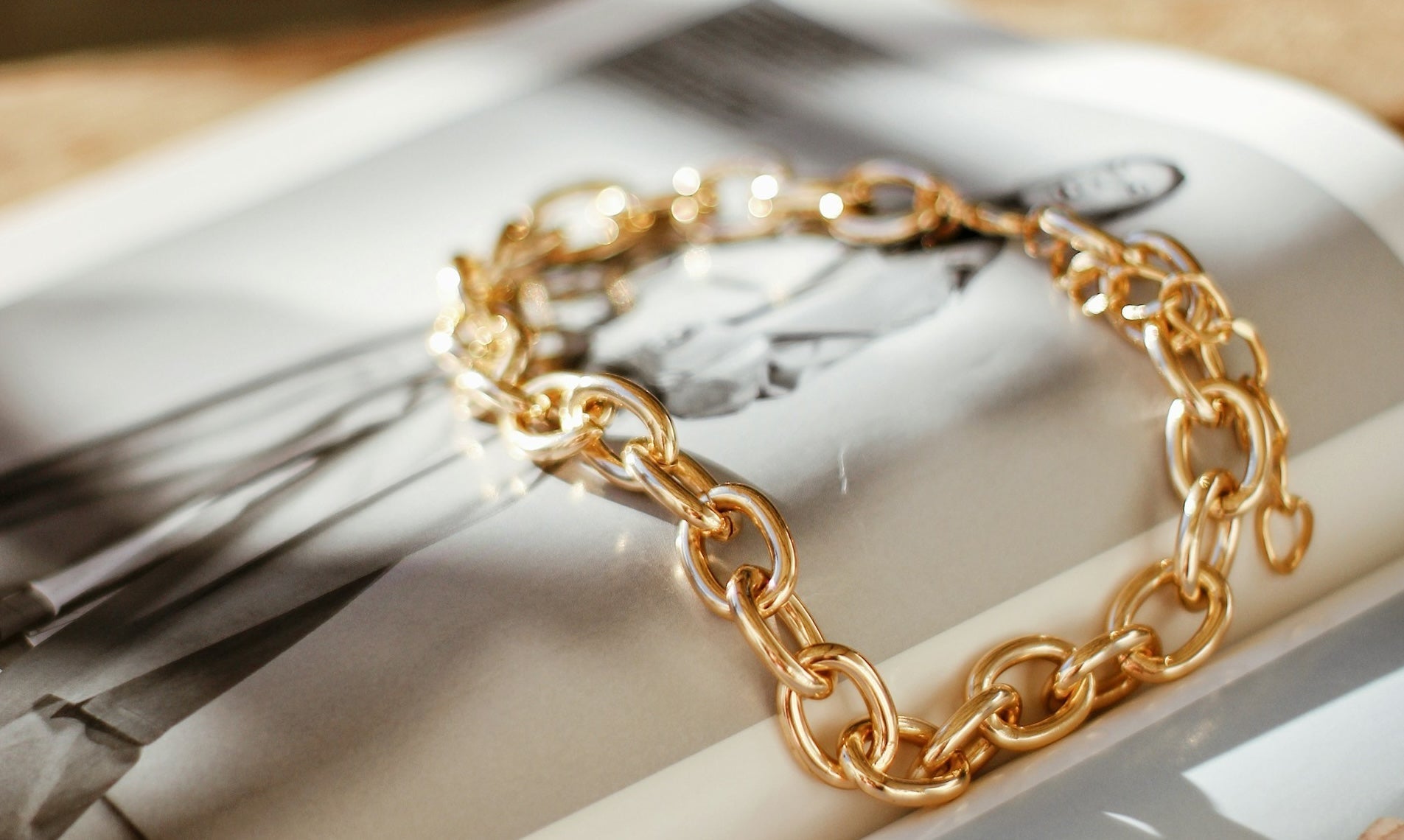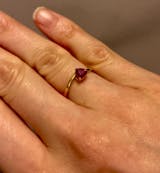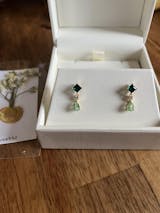
14K vs. 18K Gold: Understanding the Differences
Table of Content: Inside this Article
...When venturing into the world of fine jewellery, understanding gold purity becomes essential to making informed investment decisions. The karat system serves as the universal measurement of gold purity, indicating the proportion of pure gold relative to other metals in an alloy. This system ranges from 9K to 24K, with each increment representing different levels of gold content.
Pure gold (24K) contains 99.9% gold with minimal trace elements, making it the purest form available in jewellery. However, its exceptional softness limits practical everyday use , which is why gold is typically alloyed with other metals to enhance durability and wearability.
Among all karat options, 14K and 18K gold stand as the most popular choices worldwide , particularly for fine jewellery pieces. These two standards represent the perfect balance between gold content, durability, and aesthetic appeal—each offering unique advantages depending on your specific needs.
Understanding the subtle yet significant differences between 14K and 18K gold can dramatically impact your jewellery's appearance, durability, and investment value. Whether you're selecting an engagement ring meant to last generations or everyday pieces that withstand daily wear, the karat choice becomes a crucial decision that extends beyond mere numbers.
What Exactly Are 14K and 18K Gold?
Composition Breakdown of 14K Gold
14K gold jewellery contains 58.3% pure gold (14 parts out of 24), with the remaining 41.7% comprised of other metals such as silver, copper, nickel, zinc, or palladium. This specific composition creates an ideal balance between gold content and structural integrity, making it the most popular choice for everyday jewellery in the United Kingdom and United States.
The alloy metals in 14K gold serve distinct purposes beyond simply reducing costs. Copper adds strength and contributes to warmer tones , while silver brightens the alloy and improves workability. In white gold formulations, platinum-group metals like palladium or nickel (though nickel is now less common due to allergy concerns) create a silvery appearance.
Different 14K gold colours are achieved through varying the mix of these secondary metals:
-
Yellow 14K gold typically contains higher proportions of copper and silver
-
White 14K gold incorporates white metals like palladium or silver with a rhodium plating
-
Rose 14K gold features increased copper content for that distinctive blush tone
The substantial proportion of strengthening alloys makes 14K gold jewellery UK particularly resilient against everyday wear and tear , ideal for rings, bracelets, and other pieces exposed to daily activities.
Composition Breakdown of 18K Gold
18K gold contains 75% pure gold (18 parts out of 24), with only 25% devoted to alloying metals. This significantly higher gold content creates a richer, more luxurious appearance with that unmistakable golden luminosity that many jewellery specialists prize.
The reduced alloy content in 18K gold means there's less room for strengthening metals, resulting in a somewhat softer material compared to 14K. However, the higher gold percentage offers enhanced corrosion resistance and a deeper, more saturated colour that many find irresistibly appealing.
18K gold alloys typically include:
-
Copper and silver in yellow-gold varieties
-
Palladium, zinc and silver in white gold formulations
-
Higher copper ratios in rose gold for a more intense pink hue
The elevated gold content makes 18K pieces less likely to cause allergic reactions for those with sensitive skin, as gold itself is hypoallergenic—it's often the additional metals that may trigger sensitivities. This makes 18K an excellent choice for those with known metal allergies or for pieces that maintain prolonged skin contact.
Colour Variations Between 14K and 18K
Yellow Gold Differences
The most noticeable distinction between 14K and 18K yellow gold lies in the depth and richness of colour . 18K yellow gold displays a more vibrant, intense golden hue thanks to its higher pure gold content, creating that classic, luxurious appearance often associated with fine jewellery.
By comparison, 14K yellow gold exhibits a slightly lighter, more subtle golden tone that some prefer for its understated elegance. This lighter shade can complement certain gemstones and design styles where an intensely yellow metal might overwhelm the overall aesthetic.
Visual identification between the two can be challenging without experience, but trained eyes might notice that 18K yellow gold often appears more saturated and warmer , while 14K has a slightly paler, more neutral appearance. This colour difference becomes particularly evident when placing pieces side by side under good lighting.
For those seeking the quintessential rich gold look for special pieces like engagement rings or statement necklaces, Juvetti's collection of 18K gold pieces offers that timeless warm glow that captures attention and exudes luxury.
White Gold Variations
When comparing 14K and 18K white gold, the differences become more nuanced due to the industry-standard rhodium plating applied to most white gold jewellery. This thin layer of rhodium gives both karats a bright, platinum-like appearance initially.
However, as this plating gradually wears away with time and use, the underlying alloy becomes visible. 18K white gold typically reveals a slightly warmer, creamier white tone, while 14K white gold may show a cooler, grayer undertone due to its different alloy composition.
Maintenance requirements differ slightly between these options. The higher gold content in 18K white gold means it might require more frequent rhodium replating to maintain its brilliant white appearance, typically every 12-18 months depending on wear. 14K white gold, with its higher percentage of whitening metals, often maintains its colour longer, sometimes extending to 18-24 months between replating services.
For those who prefer the elegant look of white metals, Juvetti's white gold necklace collection offers exquisite pieces that showcase the timeless appeal of this sophisticated metal choice.
Rose Gold Distinctions
The copper content that gives rose gold its distinctive blush tone creates noticeable variations between 14K and 18K options. 14K rose gold typically contains more copper , resulting in a stronger, more pronounced pinkish-red hue that many find appealingly romantic and distinctive.
In contrast, 18K rose gold displays a subtler, softer rose tone due to its higher gold content and consequently lower copper percentage. This creates a more delicate blush that some prefer for its understated elegance and versatility.
This difference in intensity means 14K rose gold often appears more definitively "rose" in colour, while 18K rose gold presents a gentle warmth that harmoniously blends gold's yellow tones with copper's rosy influence. For those seeking a statement piece with that distinctive romantic blush, the stronger hue of 14K rose gold might be preferable, while those desiring a more subtle rose effect might gravitate toward 18K.
The beautiful rose gold options available in Juvetti's bracelet collection showcase how this romantic metal choice creates timeless pieces that combine warmth and sophistication.
How Durable is 14K / 18K Gold?
Scratch Resistance Comparison
When it comes to withstanding daily wear, the difference between 14K and 18K gold becomes particularly significant. Due to its higher percentage of alloying metals (41.7%) , 14K gold jewellery demonstrates superior scratch resistance and durability in everyday situations. These additional metals—primarily copper, silver, and zinc—contribute substantial hardness to the alloy, making it more resilient against the inevitable bumps and scrapes of daily life.
By comparison, 18K gold with its greater pure gold content (75%) inherits more of pure gold's natural softness. While visually luxurious, this higher gold percentage creates a slightly softer material that may show scratches and wear more readily over time. On the Mohs hardness scale (which measures a material's resistance to scratching), 14K gold typically rates around 3-3.5, while 18K gold jewellery generally measures about 2.5-3, illustrating this tangible difference in hardness.
For those leading active lifestyles or working with their hands, this distinction becomes particularly relevant. Professionals such as nurses, teachers, chefs, or tradespeople might find 14K gold's enhanced durability better suited to withstand their daily activities without showing premature wear. The difference becomes especially noticeable in rings, which frequently come into contact with surfaces and objects throughout the day.
Structural Strength
Beyond scratch resistance, the structural integrity of gold jewellery affects its longevity and suitability for different designs. 14K gold's higher alloy content provides enhanced strength for delicate or intricate designs where structural integrity is paramount. This makes it an excellent choice for:
-
Filigree work with fine, delicate details
-
Prong settings that secure precious gemstones
-
Chain links that must withstand tension and movement
-
Clasps and findings subject to mechanical stress
In contrast, 18K gold offers sufficient strength for most jewellery applications while delivering that coveted richer gold appearance. Its slightly softer nature can actually be advantageous in certain contexts, particularly for:
-
Custom-fitted pieces that may require minor adjustments
-
Handcrafted details where the goldsmith benefits from more malleable material
-
Larger statement pieces where weight reduction is beneficial
For everyday rings that face constant exposure to potential damage, Juvetti's durable yet elegant ring collection offers options in both karats, allowing you to select the perfect balance of durability and luxury for your lifestyle.
Skin Sensitivity and Allergic Reactions
The relationship between gold karat and potential allergic reactions represents an important consideration, particularly for those with sensitive skin. Gold allergies are relatively rare, as pure gold itself is hypoallergenic . However, the alloying metals—particularly nickel, copper, and sometimes zinc—can trigger sensitivities in susceptible individuals.
With its higher percentage of pure gold (75%) , 18K gold contains proportionally fewer potentially reactive metals, making it significantly less likely to cause allergic reactions. This makes 18K gold an excellent choice for those with known metal sensitivities or a history of reactions to jewellery. The reduced allergen exposure is especially important for pieces worn continuously, such as wedding bands or everyday earrings that maintain prolonged contact with the skin.
By contrast, 14K gold jewellery from London contains nearly 42% alloying metals, potentially including more nickel or copper that might trigger reactions in sensitive individuals. However, it's worth noting that many modern 14K formulations, particularly those from premium jewellers like Juvetti, now use nickel-free alloys specifically designed for sensitive skin . These alternative compositions replace problematic metals with more biocompatible alternatives like palladium or additional silver.
Signs of potential metal sensitivity include redness, itching, rash development, or discomfort at the point of contact. If you've experienced these symptoms with lower-karat gold in the past, upgrading to 18K might resolve these issues while still offering reasonable durability for most jewellery applications.
For those with extremely sensitive skin who still prefer the enhanced durability of 14K gold, Juvetti's hypoallergenic earring collection offers specially formulated options designed to minimize reaction risks while maintaining beautiful aesthetics.
Practical Applications: Which Karat for Which Jewellery?
Everyday Gold Jewellery Recommendations
For pieces that face constant exposure to daily activities, 14K gold UK often represents the most practical choice. Its enhanced durability makes it ideal for:
-
Engagement rings and wedding bands that will be worn continuously through all daily activities
-
Bracelets and watches that frequently contact surfaces and may bump against desks or tables
-
Everyday earrings particularly posts and backs that undergo friction when inserted
-
Chain necklaces subject to constant movement and potential tangling
The superior hardness of 14K gold helps these everyday pieces maintain their appearance with minimal maintenance, even with active lifestyles. For professionals who work with their hands— healthcare workers, artists, chefs, or those in manual trades —this durability becomes particularly valuable, resisting deformation and wear that might quickly affect softer gold alloys.
Additionally, the more affordable price point of 14K makes it accessible for larger pieces or collections where budget considerations come into play. This cost-effectiveness becomes especially relevant for trend-driven pieces that might not be intended as lifetime investments.
For beautiful everyday pieces that stand up to active lifestyles, Juvetti's bracelet collection offers durable yet sophisticated options that transition seamlessly from day to evening wear.
Special Occasion and Statement Pieces
For jewellery reserved for special events or pieces intended to make a statement, 18K gold often proves the superior choice. Its richer colour and luxurious appearance make it particularly suitable for:
-
Heirloom-quality engagement rings that prioritize visual impact and prestige
-
Significant anniversary gifts meant to commemorate important milestones
-
Statement necklaces and pendants where the rich gold colour enhances visual impact
-
Special occasion earrings that won't face the same daily wear as everyday pieces
The deeper, more intense golden hue of 18K creates an unmistakable presence that communicates luxury and significance. For pieces that will be photographed extensively—such as wedding jewellery or milestone gifts —this enhanced colour saturation can make a meaningful difference in visual impact.
Furthermore, the higher gold content in 18K pieces generally translates to better long-term value retention , an important consideration for investment pieces intended to become family heirlooms. While the initial cost is higher, this premium is often justified for significant pieces that carry emotional and financial importance.
For truly special occasions, Juvetti's exquisite necklace collection features stunning 18K gold pieces that create unforgettable impressions and timeless elegance.
When making your selection between these options, consider not just the immediate appearance but also your long-term intentions for the piece. A thoughtfully chosen karat that aligns with the jewellery's purpose will ensure years of satisfaction and appropriate performance, whether that means everyday durability or special occasion splendour.
Making Your Decision: 14K or 18K Gold Jewellery from London?
When choosing between 14K and 18K gold jewellery, your decision ultimately hinges on balancing several key factors that reflect your personal priorities, lifestyle, and the specific purpose of your jewellery piece. Consider these essential elements to guide your selection process:
Daily wear requirements should significantly influence your decision. For pieces worn continuously—like wedding bands, everyday watches, or signature bracelets—the enhanced durability of 14K gold often proves more practical. The additional hardness helps resist the inevitable scratches, bumps, and general wear that accompany daily activities, maintaining its appearance with minimal maintenance over years of continuous use.
Budget considerations naturally play a crucial role in your decision. With gold prices consistently trending upward over decades, the substantial difference in pure gold content between 14K (58.3%) and 18K (75%) translates to a significant price differential—typically 20-30% for comparable pieces. For larger items like statement necklaces or tennis bracelets, this price gap becomes particularly pronounced, potentially making 14K the more accessible option without compromising quality.
Colour preference might be the deciding factor for many jewellery enthusiasts. If you're drawn to that classic, rich golden hue that embodies luxury and tradition, 18K gold delivers that deeper yellow tone that many find irresistible. Conversely, if you prefer a more subtle golden appearance or are selecting pieces to complement specific gemstones, 14K's lighter tone might better suit your aesthetic preferences.
Skin sensitivity concerns should never be overlooked. If you've experienced previous reactions to metal jewellery—particularly redness, itching, or rash development—the higher gold content in 18K significantly reduces potential exposure to reactive metals. While quality 14K pieces (particularly from trusted jewellers like Juvetti ) increasingly feature hypoallergenic formulations, 18K provides additional peace of mind for those with known sensitivities.
Investment considerations might justify the premium for 18K gold, particularly for significant pieces intended as family heirlooms or long-term assets. The higher gold content generally translates to better value retention, with the metal value itself representing a larger proportion of the piece's overall worth. For wedding jewellery, milestone gifts, or other emotionally significant purchases, this enhanced investment quality can make 18K the wiser long-term choice.
Regional preferences sometimes influence what's readily available in your market. In the United Kingdom and most European countries, 18K gold has traditionally been preferred and more widely available, particularly for fine jewellery. In contrast, 14K dominates the American market, striking that practical balance between durability and gold content that resonates with more active, everyday-wear preferences.
For those torn between these options, consider this practical approach: 14K for daily wear pieces subject to regular activity and exposure, and 18K for special occasion jewellery or significant pieces where that extra touch of luxury enhances their emotional and aesthetic impact. This balanced strategy allows you to experience the advantages of both standards while maximizing value and enjoyment across your collection.
Ultimately, either choice represents a quality investment in precious metal jewellery that, with proper care, will provide enjoyment for generations. The exceptional craftsmanship found in Juvetti's stunning collections ensures that regardless of karat choice, you're investing in beautifully designed, ethically produced pieces that stand the test of time.
Conclusion
The choice between 14K and 18K gold extends far beyond simple numbers, reflecting a thoughtful balance between practical durability, aesthetic preference, and investment value. While 14K gold jewellery offers superior hardness and everyday wearability at a more accessible price point, 18K gold delivers that unmistakable rich golden lustre with enhanced hypoallergenic properties that many consider worth the premium.
Rather than viewing one option as universally superior, consider your selection in the context of the jewellery's specific purpose and wearing conditions. Wedding bands and everyday pieces benefit from 14K's resilience, while special occasion jewellery and heirloom-quality items gain emotional and visual impact from 18K's deeper golden hue and higher precious metal content.
Regardless of karat selection, quality craftsmanship remains paramount. By choosing pieces from reputable jewellers like Juvetti, who prioritise ethical sourcing and exceptional artisanship, you ensure that your gold jewellery will continue to bring joy and beauty for generations to come.
Before making your final decision, consult with knowledgeable jewellery professionals who can guide your selection based on your unique lifestyle, budget, and aesthetic preferences. With thoughtful consideration of these factors, your chosen gold jewellery will provide years of satisfaction, beauty, and value—regardless of whether it's crafted in 14K or 18K gold.
Frequently Asked Questions
Is 14K or 18K gold better for engagement rings?
- Both options have merit depending on lifestyle and preferences. 18K gold offers richer colour and prestige ideal for this significant purchase, while 14K provides enhanced durability for everyday wear. For active individuals, 14K might better withstand daily activities, while those prioritising traditional luxury often prefer 18K's deeper golden hue and investment quality.
Is 18K gold jewellery worth the price premium over 14K?
- For special pieces, heirlooms, or those with skin sensitivities, 18K gold often justifies its higher cost through enhanced appearance, hypoallergenic properties, and better value retention. For everyday jewellery subject to regular wear, the durability advantages and cost savings of 14K may represent better overall value.
Does 14K or 18K gold tarnish?
- Neither 14K nor 18K gold will tarnish in the traditional sense. However, 14K gold, with its higher percentage of non-gold metals, may develop a slightly dulled appearance over time due to microscopic oxidation of these alloy components. This is easily remedied with routine cleaning and occasional professional polishing.
How can I test if my gold is really 14K or 18K?
- The most reliable verification comes from hallmarks—small stamps indicating "14K," "18K," "585" (14K), or "750" (18K). Professional jewellers can perform acid tests or use electronic gold testers for verification. Home testing kits are available but less reliable than professional assessment.
Can I wear 18K gold jewellery every day?
- Yes, 18K gold is suitable for everyday wear, particularly for those with gentle wearing habits or in pieces less exposed to impact (like earrings or pendants). For rings or bracelets subjected to more active conditions, be mindful that 18K will show wear somewhat faster than 14K alternatives and may require more frequent professional maintenance.









